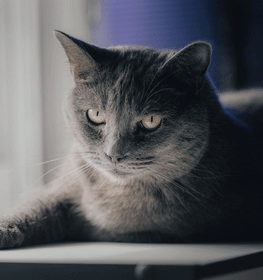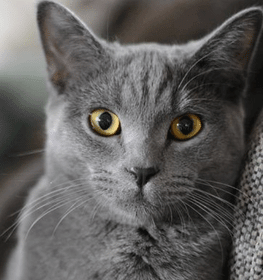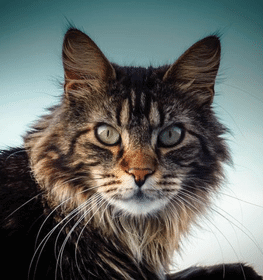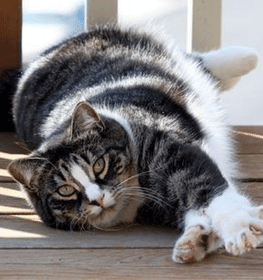Russian Blue Cat Breed Information and Facts
This page is about the Russian Blue cat breed information and what it means to own one as a companion animal. If you are considering getting Russian Blue cat breed, this profile will be helpful in deciding whether or not they are right for you!
| Group | Natural |
|---|---|
| Popularity Rank | 11 |
| Reviews | 0 |
| User Ratings | |
|
Compare the Russian Blue With Other Cats
Select at least one cat breed to make the comparsion. | |
 | |
| Origin | |
|
Other Names
What other names are there for the Russian Blue cat? | Archangel Blue, Archangel Cat |
|---|---|
|
Price
What is the cost of a Russian Blue cat? | $1000 to $1700 If you choose to purchase the Russian Blue cat, you should know that the mentioned amount of money is an average of the collected data from breeders’ sites and cat finder places. If you have a Russian Blue cat for sale, please advertise it on a reliable website to make sure the Russian Blue gets to a happy place. |
| Cost Of Ownership | Moderate |
| Breed Recognition | The International Cat Association (TICA)Cat Fanciers' Association (CFA)American Cat Fanciers Association (ACFA)Fédération Internationale Féline (FIFe) |
|
Size
How big is a Russian Blue cat? | Medium The medium-sized cats usually weigh 10-15 pounds and are 8-11 inches long from the nose down. |
|---|---|
|
Weight
What is the weight of the Russian Blue cat? | Male: 10 - 15 pounds, Female: 7 - 12 pounds |
| Bite Force | Average Bite Strength: Around 10-15 PSI An average cat bite strength, usually ranging from 10-15 PSI, is commonly observed in medium-sized cat breeds such as the Russian Blue or those with moderate jaw muscle development. While these cats possess a stronger bite compared to smaller breeds, ensuring proper socialization and comprehending feline body language remain crucial to avoid biting incidents. Cat owners investigating average bite strength in cats, medium bite force breeds, or specific breeds like the Russian Blue will find this category informative and useful. |
| Body Type | Semi-foreign Russian Blue have a moderate build, more elongated than cobby cats but not as slender as foreign cats. They have a balanced appearance. Examples include the Abyssinian and Somali. |
| Ear Shape | LargePointedWide-set |
| Eye Color | Green |
| Hair Color and Pattern | Solid blue-grey coat with a silvery sheen. |
|
Coat
What kind of coat does the Russian Blue cat have? | Short Hair |
| Leg Lenght | Medium |
| Whisker Length | Medium |
| Musculature | Lean |
| Head Shape | Triangular |
| Toe Count | 5 front4 back |
| Eye Shape And Orientation | Small and Deep-set |
| Night Vision | |
| Paw Size | Medium |
| Nose Structure | Straight |
| Neck Length | Medium |
| Fur Texture | SilkyLong |
| Bone Density | Medium |
| Flexibility | High |
| Bone Structure | SlenderFine |
| Tail Length | Long and Tapered |
| Sleep Patterns | Average |
| Attention Span | Moderate, shy and observant |
|---|---|
| Guarding Instinct | Moderate |
| Protection Instincts | Moderate |
| Climbing Ability | Moderate |
| Jumping Ability | Good |
| Swimming Ability | Poor |
| Water Affinity | |
| Rescue Capability | Poor |
| Litter Size | 4-6 Kittens |
|---|---|
| Special Needs | Low maintenanceIndependent |
| Breeding | Requires experienced breeders, small litter size |
| Dietary Preferences | High protein, wet food |
| Solo Time Tolerance | Medium |
| Noise Sensitivity | Low |
| Genetic Diversity | Low |
| Sensitivity To Changes | Medium sensitivity |
| Food Motivation | Moderate |
| Feeding Schedule | Twice a dayMorning and Evening |
| Maintenance Level | High |
| Exercise Needs | Low |
|
Life Expectancy
What is the life expectancy of the Russian Blue cats? | 10-16 years |
|
Energy Level
How energetic is the Russian Blue cat? | The Russian Blue cat has an average energy level. |
|
Hypoallergenic
Are Russian Blue cats hypoallergenic? | Yes Russian Blue cats do well with allergy sufferers by causing fewer allergic reactions. However there are no 100% hypoallergenic cats in the world, there are a variety of breeds that are considered to reduce or minimize the possibility of an allergic response.
Coat type isn't necessarily relevant, because most people are allergic to dander (flakes on the cat's skin) or saliva, not actually to cat hair. |
|
Common Health Issues
Are Russian Blue cats a healthy breed? | Low Very healthy cat breed. The Russian Blue rarely meets with the veterinarian. |
| Health Problems | Hypertrophic Cardiomyopathy (HCM)ObesityBladder Stones |
| Climate | Temperate |
| Cold Tolerance | Medium |
| Heat Tolerance | Low |
| Breeding Difficulty | Easy |
| Common Vocalizations | Quiet and shy meows |
|---|---|
| Interaction With Other Pets | Good, but can be shy |
| Facial Expression | Shy and loyal |
| Tail Behavior | Shy and loyal tail movements |
| Explorer Instincts | Moderate |
| Attention Needs | Moderate |
| Protectiveness | Moderate |
| Territoriality | Moderate |
| Independence | High |
| Response To Commands | High |
| Adaptability To Indoor Life | High |
| Hunting Drive | High |
| Play Style | PlayfulGentleCalm |
| Escape Tendencies | High |
| Curiosity | High |
| Hunting Skills | Moderate ⏺️ |
| Reaction To Strangers | Cautious |
| Stalking Behavior | High |
| Aggression Level | Moderate |
| Training Difficulty | Easy |
| Agility | High |
| Travel Compatibility | Low |
| Activity | Low Active |
| Compatibility With Other Animals | LowIndependent |
| Household Noise Tolerance | Medium |
| Playfulness | Active Adventurer. Russian Blue are quite playful and enjoy frequent play sessions. They are curious and active, often engaging in interactive games and activities. |
|
Trainability
Are Russian Blue cats easy to train? How hard is it to train a Russian Blue? | Average Trainability: Russian Blue cat breeds are less interested in training and obedience, but can still learn basic commands and routines with enough practice and rewards. Examples of average trainable cat breeds include Persian, Russian Blue, and British Shorthair. |
|
Lap Cat
Are Russian Blue cats lap cats? | Yes This cat loves to sit on his owner's lap. |
|
Temperament
What personality do Russian Blue cats have? | Active |
|
Adaptability
Are Ragdoll cats adaptable? | Average: Russian Blue cats adapt to lifestyle changes and different living environments quite okay usually. |
|
Affection Level
Are Russian Blue cats more affectionate? | Average: Russian Blue cats are average regarding their affection level. Some breeds are forthcoming and friendly, while others are independent and don't bond too closely with their owners.
|
|
Child Friendly
Are Russian Blue cats good with kids? | The Russian Blue cat is a child-friendly breed. This breed is a good choice if you have children. |
|
Dog Friendly
Are Russian Blue cats good with dogs? | Russian Blue cats are average friendly toward dogs. |
|
Intelligence
Are Russian Blue cats intelligent? Are Russian Blue cats smart? | Average: the Russian Blue cat has an average level of intelligence. |
|
Social Needs
Are Russian Blue cats social? | Average: they need as much social interaction as the average cat. |
|
Stranger Friendly
Are Russian Blue cats friendly to strangers? | Average: this cat breed gets on relatively well with strangers. |
|
Vocalization
Do Russian Blue cats vocalize? | Low Low vocalization cats are a category of cats that typically make less noise than other cats. This can be due to a variety of reasons, including genetic disposition, health, or even personality. While some low vocalization cats may simply be quiet by nature, others may only meow when they are distressed or in need of attention. Low vocalization cats can make excellent pets for those who are looking for a feline companion that is relatively low maintenance in terms of noise. |
| Seasonal Shedding | Low |
|---|---|
| Grooming Tools Needed | BrushNail ClipperCombDeshedding Tool |
| Dental Care | Moderate Cat breeds like the Russian Blue, classified under moderate dental care needs, display a higher likelihood of encountering dental concerns compared to those with low dental care needs. Factors contributing to their increased risk may involve genetic predispositions or particular breed traits. These cats benefit greatly from a regular dental care routine, encompassing teeth brushing, dental cleanings, and veterinary check-ups, to prevent the onset of common dental problems such as gingivitis, periodontal disease, and tooth decay. |
|
Grooming
How to groom your Russian Blue cat? | Moderate Maintenance Grooming your Russian Blue cat is an essential part of caring for their health and well-being. Regular brushing helps remove dirt, and dead hair from the surface to stimulate blood circulation which can lead to a better quality coat with a smoother texture! |
|
Shedding
Do Russian Blue cats shed a lot? | Moderate This cat breed is of average shedding. Anyone who has ever shared a home with a cat knows that shedding can be a challenge. Fortunately, there are a few things you can do to minimize the amount of fur your Russian Blue cat leaves behind. First, regular grooming is essential. Brushing your cat daily will help remove loose hair before it gets on furniture or clothing. Also, make sure Russian Blue cat gets plenty of good quality food and water. A healthy diet will help keep your cat's coat in good condition and reduce shedding. |
Russian Blue Pros and Cons
Pros
- Child Friendly: The Russian Blue cat is a child-friendly breed.




